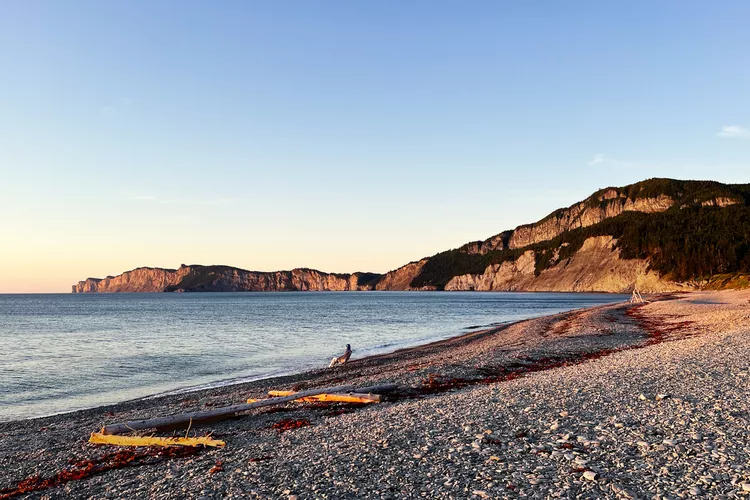Summary of Gaspé Exploration
Discovering the Hidden Gem
Reaching out from Canada’s eastern shore, the rocky, remote Gaspé Peninsula is one of the country’s best-kept secrets.
My first taste of the Gaspé Peninsula was a mouthful of flowers: a spoon piled with petals was offered to me when I visited five years ago. Quebecers are surprised when I tell them about it. That’s partly because the fertile eastern hunk of Canada, jutting out into the Gulf of St. Lawrence as if it were trying to visit Newfoundland, is where much of the population of Quebec went for their childhood holidays without being much disturbed by international tourists like me. It’s also because, while the Gaspé is famous for a type of food, it isn’t flowers. It’s fish.
When I went back last September with my husband, Craig, to make a full circuit of the peninsula, I discovered that, even in our age of disappearing resources, that is still the case. There are 22 salmon rivers on the peninsula, their clear water fringed with trees. Fantastic fresh seafood is served everywhere, from small island shacks to stylish waterside restaurants. But the fish have always been more than just dinner. The history of the peninsula could be written in fins and scales.
Rich History and Culture
The Indigenous people whose ancestral territory this is, the Mi’kmaq, probably migrated east up the St. Lawrence River, past what is now Montreal and Quebec City, then stayed because the food was so plentiful. Around the year 1000, the Vikings showed up to fish cod, then dry and salt it for transport across the Atlantic. In 1534, Jacques Cartier arrived, planted a large crucifix in what is now the town of Gaspé, and claimed the entire country for France. Gaspésie, the French name for the peninsula, comes from the Mi’kmaq name Gespeg, meaning “land’s end.” But given that the Atlantic was the medieval equivalent of a highway connecting North America to Europe, “land’s beginning” might be just as appropriate.
We plotted a weeklong trip that would take us on a 565-mile loop northeast from Quebec City along the St. Lawrence River. We would pause at the farthest point for a brief flirt with the Gulf of St. Lawrence, then return via Chaleur Bay, the water always on our left, sometimes so close that it seemed we might cast off.
Culinary Delights of the Peninsula
We began at Pointe-au-Père with a reminder that wild water is far more than just a beautiful backdrop. We climbed the first of the slender, elegant red-and-white lighthouses that warn vessels away from the banks of the St. Lawrence and visited the next-door museum, in a building shaped like a sinking ship, that commemorates one instance where that warning proved futile. A dramatic film about the ocean liner Empress of Ireland sank in 1914 on its way from Quebec to Liverpool, emphasizing the region’s connection to maritime history.
We headed farther along the river in the direction of Reford Gardens, a botanical paradise near the village of Grand-Métis, about 200 miles northeast of Quebec City. It was this improbable, beautiful place that had made me curious about the rest of the peninsula.
On this trip, as was the case five years ago, there often seemed to be petals on my plate—unsurprising, perhaps, in a peninsula with four national parks and a range of flora so wide that it was a favorite destination for the great Québécois botanist Frère Marie-Victorin.
Still, even more frequently than flowers, I was served fish. The culinary experience was extensive; from a rich soup at Café de l’Anse on the riverbank near Forillon National Park to a remarkable lobster sandwich at Resto des Margaulx on Bonaventure Island, where uninhabited yet pure natural beauty awaited. Enjoying fresh oysters from local fisheries only enhanced our gastronomic tour of the Gaspé Peninsula.
Embarking on Your Adventure
We carried on driving west along the peninsula’s southern shore toward Carleton-sur-Mer. The water of Chaleur Bay so luminous it made the sky look dull and came so close to the level of the road that it seemed as if the two means of transport were greeting one another. Conversations with locals enriched our experience, sharing tips and insights that made our visit even more memorable.
As we explored, we reveled in the majestic views and rich history tied to fishing, both as a way of life and an emblem of the region’s culture. The Gaspé Peninsula represents not just a beautiful travel destination but also a testament to the people and nature that have thrived over centuries.
Consequently, from the stunning vistas of the cliffs and wildlife to the delightful local seafood, the Gaspé Peninsula offers an enriching experience for any traveler eager to connect with nature and history.





